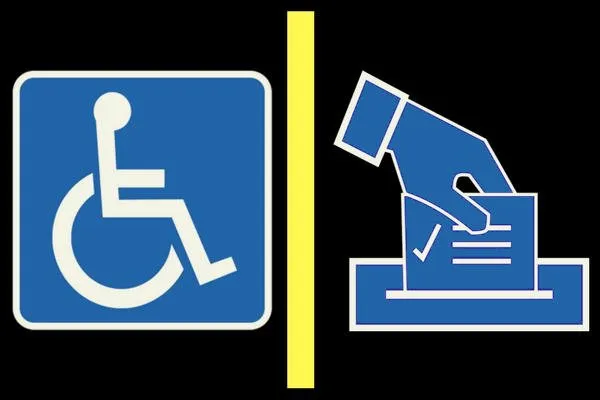The ability to freely cast a ballot is fundamental to democracy. While most adults in the US have the right to vote (those convicted of felonies being a major exclusion), many in this country still face serious practical barriers to casting a ballot.
One group facing such obstacles are people with disabilities, who vote at a significantly lower rate than those without disabilities. Most of us can understand that this is an issue. However, a recent report from Rutgers University has shown just how big a problem voting with disabilities actually is – especially for Kentucky.
Nationwide, nearly 1 in 5 Americans lives with some level of disability, including around 35 million voting-age people. In Kentucky, around 18% of the population, over 800,000 people, has some form of disability. This total is likely to increase as the population ages.
Kentucky, worst in the nation
| According to the Rutgers study, 55.9% of those with disabilities in the US voted in the 2016 elections, compared to 62.2% of those without disabilities. This is a -6.3% difference between the two groups, known as a disability gap.
The disability gap serves as a measure of how difficult it is for voters with disabilities to cast a ballot. If turnout was just about motivation or enthusiasm, disabled and non-disabled people should vote at similar rates. The fact that they don’t, then, shows that something is keeping people with disabilities away from the polls. In 2016, Kentucky had the lowest turnout rate among people with disabilities of any state in the country at 42.5%. We were 50th out of 50. Making the issue worse, we also had the largest disability gap (-17.6%), as 60.2% of voters without disabilities voted, compared to that 42.5%. Furthermore, we are headed in the wrong direction. The disability turnout rate and disability gap were both significantly worse in 2016 than they were in 2012. This is unfortunately not surprising. Kentucky has for years been ranked at or near the bottom of states when it comes to supporting people with disabilities. Why is it so difficult?There are many factors that contribute to the difficulty that people with disabilities experience when voting. To begin, many people with disabilities are limited in terms of transportation, meaning they can have trouble even getting to their polling location. Once at the polls, getting into the polling location can present its own problem. Many buildings used for polling locations are older and may not have been designed to accommodate everyone. A GAO study from December found that nearly 65% of polling places had at least one form of physical impediment. These can include a lack of handicapped parking spaces, ramps which are too steep, handicapped accessible entrances which are locked, and turns which are too narrow. |
Summary Points The Problems
|
If you can’t get in the building, curbside voting may be available, but this robs voters of the ability to cast a private ballot. If you are able to get in, there are often issues with paper ballots or voting machines. Not everyone can read or mark a paper ballot, and voters and poll workers may not fully understand how to use an accessible voting machine.
Not all of these factors are directly related to casting a ballot. There are also social factors at play. People with disabilities are more likely to be single, more likely to live in poverty, and less likely to have attained higher levels of education, all of which are factors that cause lower turnout among all populations, disabled or not.
What can be done
We know more can be done, because other states have had success improving turnout. According to the Rutgers study, in eight states, people with disabilities actually vote at higher rates than people without disabilities. In 2016, Nebraska had the highest overall turnout rate for those with disabilities at 70.4%. In Hawaii, people with disabilities were 7.7 percentage points more likely to vote than those without disabilities.
Some actions are fairly straightforward, even if they take work or money. To begin, states and counties should ensure that polling places are ADA compliant. If time or money is a concern, the ADA also has a list of temporary measures that can help with some of the most common issues.
In general, ensuring that people with disabilities can get to, and get into, a polling place is the first step. Providing transportation to and from the polls, or mail-in voting options, would help those with mobility issues. If the polling station is not accessible, allowing voters to cast a ballot at a location that is accessible would help. We could establish a mobile voting operation where the polls come to the voter. Training poll workers to better understand what obstacles exist would also be of benefit, as would ensuring that polling machines are accessible and operational.
One state which has been proactive about helping those with disabilities is Colorado, which had the second highest turnout rate in 2016 (69%). For more than a decade, groups have been meeting with county clerks to ensure that polling locations are accessible. Since at least 2013, the Secretary of State’s office has released a county-by-county audit on the accessibility of polling places after each election.
And in Kentucky?
Kentucky has taken some steps. There is a video for both poll workers and voters with disabilities to help people know what to do and what sort of accommodations are available. There are also audits of each polling location in the state, which show any accessibility issues present.
Many of these audits, however, are more than a decade old. A lot can change in a decade. Sidewalks can crack to a point where wheelchairs can’t cross them. Automatic doors may not function as well as they used to.
Some counties, it should be pointed out, have up-to-date audits. Most of Jefferson County’s, for example, have been completed within the last year.
Kentucky has also put forth several early voting bills recently. Four were proposed in 2017 (all of which failed, however). A bill did pass with an amendment allowing for mail-in absentee or in-person voting for people with disabilities. This was a bipartisan effort and had been supported by Secretary of State Grimes. There has not been a major election since the bill’s passage, but it is likely to help. SB 14 has been proposed this session by Senators Neal and Thomas which would establish early voting and extending polling hours.
As stated earlier, not all of these factors are strictly electoral in nature. Increasing educational and employment opportunities raises the level of voter turnout for all populations, and would do the same for those with disabilities.
We need multiple solutions
These are just some solutions to help people with disabilities vote. It is important to realize, however, that no one action will solve the problem. It will take an “all-of-the-above” approach.
Mail-in ballots are great, but they can’t be relied on as a secondary option to avoid making polling stations accessible. Mail-in ballots also would be difficult for people with vision impairments. Allowing people to vote in other locations would help them get in a polling place, but would also force them to travel farther, and would separate them from other voters in their community. Early voting is great, but will not help if people still can’t get to the polling place.
We have to do this now
Kentucky has a lot of work to do to improve turnout and improve democracy for all. We are about to have three years of elections in a row, which presents us with both enormous opportunity to improve the situation, and also a great sense of urgency.
Expanding the ability to vote is vital to democracy in our state. And these actions would be effective. According to the Rutgers study, those with disabilities who don’t vote are still more likely to be registered and to have met any deadlines, are more likely to believe in their ability to make a difference, and are more likely to care about politics than non-voters without disabilities. There is no lack of motivation. It is an issue of access, and we should do everything in our power to ensure that access for all.
We have seen results in other places across the country. We know it can be done. For the good of our state, our citizens, and our democracy, we must improve, and we must improve both significantly and soon.
–30–








